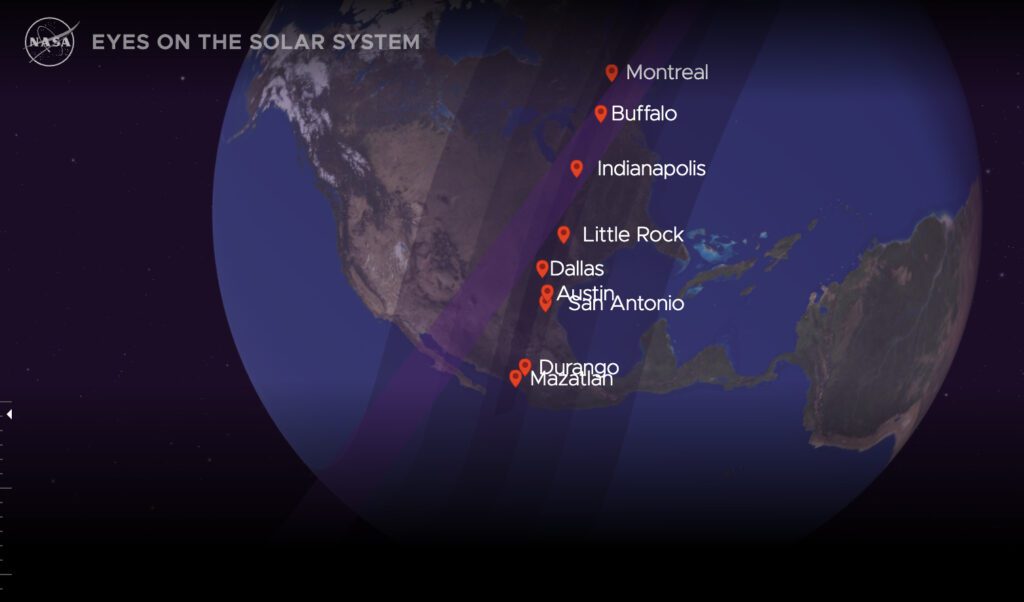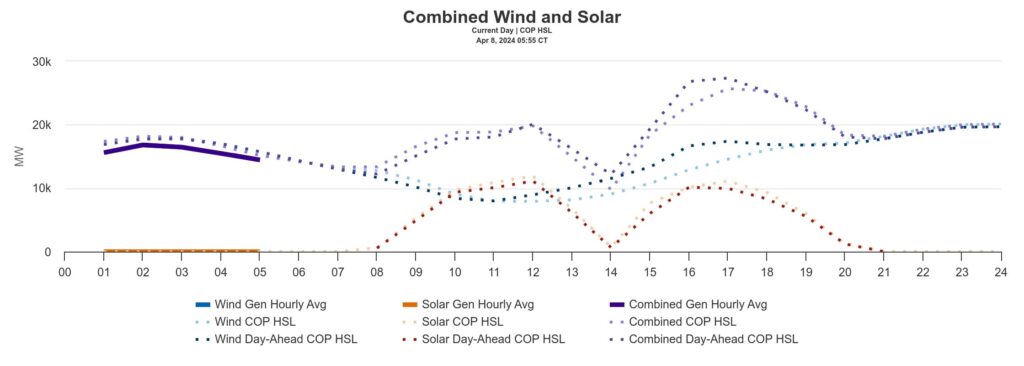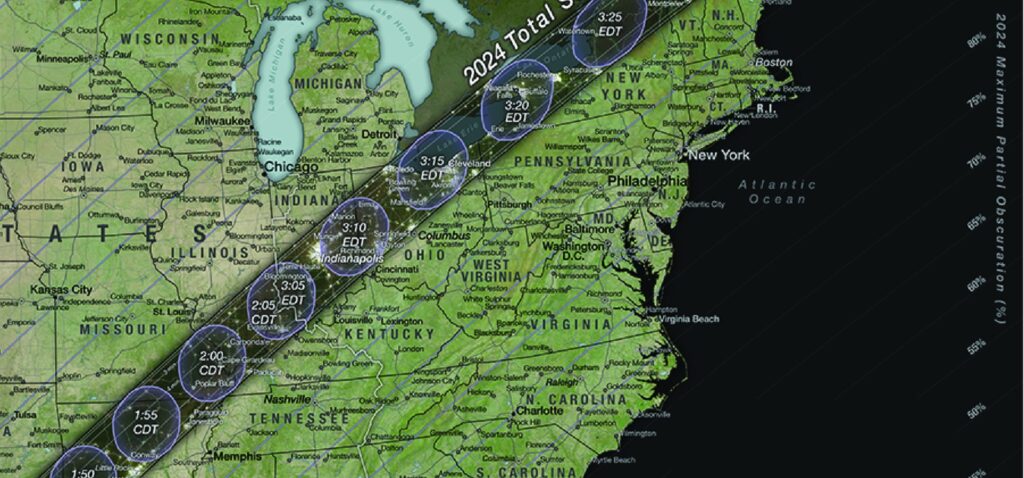Grids Brace for Solar Eclipse, Totality Poised to Test Ramping
Grid operators across the U.S. report they are largely prepared for the total solar eclipse that will pass over a large swath of North America on April 8, though they remain vigilant, monitoring for any unexpected shifts in power generation or demand that could test the power system’s resilience.
The much-anticipated solar eclipse will begin around midday today. Totality—complete blockage of the sun’s light by the moon—will first be viewable on Mexico’s Pacific coast just after 11 a.m. PST. The eclipse will then loop up the Northeast, passing 13 U.S. states, from Texas to Maine, before continuing into Canada and exiting the Atlantic coast of Newfoundland just after 5 p.m. According to NASA, at most, totality will last for a share of under four-and-a-half minutes.

The North American power system has been preparing for the rare celestial event, given that the moon’s shadow will cause a temporary but potentially significant reduction in solar power output. According to the Energy Information Administration (EIA), that concern is rooted in recent, dramatic shifts in the U.S. electricity portfolio. Since the last similar event—an August 2017 eclipse that showed “minor” effects on the power system—“almost 100 GW of utility-scale and small-scale solar capacity has been added to the system,” the EIA noted. “Even with the eclipse, we still expect solar generation to be the third-largest contributor of electricity in the U.S. on April 8, behind natural gas and nuclear.”
So far, however, reliability impacts are not expected. The eclipse “will be passing through a part of the country where we do have an awful lot of solar resource, particularly Texas,” Jim Robb, president and CEO of the North American Electric Reliability Corp. (NERC), told reporters on April 4. “But because it’s in April, it’s a low-load month anyway. The [reliability coordinators] across the path of totality, which is where you really see the implications of the eclipse, are feeling quite confident in their plans for addressing it,” he said.
Biggest Impacts Projected for ERCOT, PJM
The most significant impacts are expected in the Electric Reliability Council of Texas (ERCOT), where solar generation will dip dramatically between 12:10 p.m. and 3:10 p.m. CST, and most prominently, at around 1:40 CST. The grid operator serving 90% of Texas suggests solar generation could fall from more than 10 GW to about 1.3 GW over the two hours it experiences totality, Reuters reported. During that period, demand is expected to ramp up to 51,539 MW.
At the end of February, ERCOT had projected solar generation could fall to about 7.6% of its maximum clear sky output. It also noted that wind and load forecasts could be affected by weather and influence ramping needs. However, ERCOT said it has been working to “pre-posture” the system as necessary to meet both the down and up solar ramps and use ancillary services for additional balancing needs.
ERCOT has since confirmed it does not expect grid reliability concerns. “ERCOT has been proactively working on forecasting models to reflect reduced solar power production (similar to a sunset and sunrise in the middle of the day) and does not expect any grid reliability concerns during the eclipse,” it said.

At PJM Interconnection, much of Ohio and parts of western Pennsylvania are within the 122-mile-wide “path of totality.” On April 4, the grid operator said the total solar eclipse would impact its footprint from about 2 p.m. to 4 p.m., temporarily reducing grid-connected or metered solar resources by at least 85% to 100%.
“To date, PJM predicts reductions of about 4,800 MW of grid-connected solar generation that would have been available absent the eclipse,” it said. “At the same time, PJM expects load, or electricity demand, to increase on the order of an estimated 4,200 MW of generation, reduced from behind-the-meter solar.” While “eclipse tourism” could prompt load uncertainty, PJM does not expect it would affect loads during the actual eclipse event. In addition, the weather forecast predicts relatively mild temperatures for the time of year and a partly cloudy day, it noted.
PJM suggested the grid is prepared. “We have come up with different operational strategies,” said Kevin Hatch, PJM senior manager of Dispatch. These range from “clear skies that would impact the most solar generation to a stormy day with minimal impacts.” PJM said it has acted to “make fast-start generation resources available to ramp quickly when called upon if needed to maintain system frequency by replacing lost solar power.” In addition, it has deferred planned maintenance generation outages for fast-start resources such as combustion turbine engines and plans to manage transmission congestion impacts caused by generation losses and replacement generation.

SPP and MISO Ready to Replace Capacity
The Midcontinent Independent System Operator (MISO) has undertaken similar preparations. “We don’t expect any reliability-related issues, but we’ll be prepared for anything,” the grid operator said on April 2.
MISO noted that during the 2017 eclipse, it had 100 MW of available solar generation. “Today, there is more than 5,000 MW. That’s a big change and the reason our operations team is busily preparing for April 8,” it said.
The “big unknown,” it said, is the weather on April 8. “A sunny, cloudless day could result in an estimated 4 GW drop in generation over the course of 90 minutes. And a 3 GW rebound. Clouds will lessen those numbers.” The path of totality will cross over its South and Central regions to include parts of Arkansas, Missouri, Kentucky, Illinois, and Indiana, with shifts in darkness occurring from 1:30 to 4:25 p.m. EST, it noted.
MISO highlighted several factors that make forecasting difficult, including load uncertainty and cooler temperatures. “Each critical event tends to bring a unique set of risks to manage the system reliably and efficiently, and we expect this eclipse to be no different,” said Jason Howard, MISO director of Operations Risk Management. “The 2017 and 2023 eclipses were great warm-up drills, and our team is committed to ensuring our control centers have the information they need to reliably manage our footprint.”
Southwest Power Pool (SPP) on Friday also confirmed it is prepared for the effects of the eclipse. “The majority of SPP’s service territory will experience 50-75% eclipse coverage with a portion of the region and its operating center directly in the eclipse’s path of totality,” the grid operator said. Like other regions, SPP expects a “significant influx of people looking to experience the eclipse’s totality.”
However, an SPP analysis shows that the eclipse’s total net impact on available generating capacity—including grid-connected and distributed solar—should remain below 1 GW of reduced production. “SPP has ample generating capacity provided by other resources (e.g., coal, natural gas, wind, nuclear, hydro, and others) to make up for any potential loss and expects modest demand for electricity that day.”
Historically, region-wide demand for electricity in the SPP region in early April has “typically peaked below 33 GW,” it noted. In addition, the grid operator has factored in lessons from past events. “Having evaluated worst-case scenarios and learned from the August 17, 2017, eclipse, which was the first to affect large portions of its territory, SPP expects no significant impacts to the grid or its operating center,” it said.
A Different Predicament for the Northeast
The eclipse notably presents a different predicament for Northeastern grid operators, which will experience totality later in the afternoon, ahead of the evening solar ramp down.
At the New York Independent System Operator (NYISO), solar production is set to fall 3.5 GW as the eclipse begins at 3:16 pm EST. The event will end at 3:29 pm. “In little more than an hour, that production will likely drop to as few as 300 MW before rising quickly again to about 2,000 MW and then declining quickly in the waning hours of the afternoon,” NYISO said.
The loss of nearly 3 GW of generation “is significant, even when it can be anticipated, and requires additional resources to be available for the system to account for the loss,” the grid operator added. “Since over 90% of statewide solar generation is provided by behind-the-meter (BTM) resources, there are additional challenges from a lack of real-time visibility. Nonetheless, grid operators must still make up for any lost production to reliably serve demand.”
During the 2017 eclipse, “the sun became roughly 75% obscured and subsequently cut solar generation in New York by about 500 MW,” said Mark Taylor, a NYISO technical specialist and meteorologist at the “Today, we have five times as much solar generation throughout the state, but the amount of cloud cover will ultimately determine how much generation is lost during the eclipse.” NYISO said it has been studying the eclipse’s potential effects for months. Forecasting tools will help planners and operators determine resource needs to meet expected demand, it said.
In ISO New England, the moon’s shadow will envelop northern Vermont and northern New Hampshire from 2:15 to 4:40 p.m. EST. “According to NASA, all parts of New England will see at least 80% of the sun blocked by the moon during the peak of the eclipse,” ISO New England said.
“Depending on the amount of cloud cover, the solar eclipse is expected to result in significant ramping of solar PV output (up to as much as +/-6,000 MW) over a short period of time (i.e., about 2 ½ hours),” it noted in a market notice. So far, ISO New England has increased the requirements for Regulation Capacity and Regulation Service to 400 MW and 4,000 MW-miles. “ISO New England has been making preparations to reliably manage the impacts and uncertainty associated with this event and raising the Regulation requirements is an example of one of the precautions ISO is taking,” it said.
Ontario’s grid operator, the Independent Electricity System Operator (IESO), in an email to POWER said the eclipse would pass over the southern part of the Canadian province from about 2 p.m. to 4:30 p.m, with totality spanning about three and a half minutes. IESO said it expected to lose as much as 1.5 GW of solar power during the eclipse. “The IESO is confident and will ensure that there is adequate supply on the grid during the eclipse,” it said. “Most of Ontario’s solar facilities are connected to local distribution networks, not the provincial transmission grid,” it noted.
IESO said that as solar output falls, other generators on the grid will step in, fulfilling its need to ramp up and down to make up for the shortfall. However, IESO also noted that it could respond to export requests from the U.S. “The IESO is taking this into account during planning, while ensuring Ontario’s energy needs are met first,” it said.
West Bracing for Effects From Partial Eclipse
While the path of totality does not cross the West, the California Independent System Operator (CAISO)—a grid that relies extensively on renewables—the Western Energy Imbalance Market (WEIM), Reliability Coordinator West (RC West), and other balancing authority areas (BAAs), have studied potential impacts from today’s wide-ranging partial eclipse.
The WEIM, which covers much of the West, expects that the partial eclipse will occur from 10 a.m. through 1 p.m. PDT. “The range that the sun will be obscured varies from 89% in southeast New Mexico to 16% in northwest Washington,” CAISO said in a March bulletin. “The reduction in solar radiation will directly affect the output of photovoltaic (PV) generating facilities, behind-the-meter (BTM) rooftop solar, load, and net load within the CAISO BAA and the WEIM,” it said.
However, compared to an annular eclipse that occurred in October 2023, today’s eclipse will have “far less” of an effect, it said. “Solar obscuration across California and the West will be far less than in October, and the impacts to load and grid-scale renewables will be less significant,” it said. “This is true even though CAISO grid-scale and rooftop solar have grown by over 2,000 MW and 1,420 MW respectively since October 2023, and WEIM grid-scale and rooftop solar have grown by 1,870 MW and 445 MW since October.”
In the West, electricity grids are also “more interconnected than ever,” it noted. CAISO has studied the potential effects of widespread solar generation loss during the three-hour eclipse, identifying risks and solutions and coordinating with WEIM participants, the Reliability Coordinator West (RC West), and other balancing authorities and stakeholders to maintain grid reliability.”
—Sonal Patel is a POWER senior editor (@sonalcpatel, @POWERmagazine).